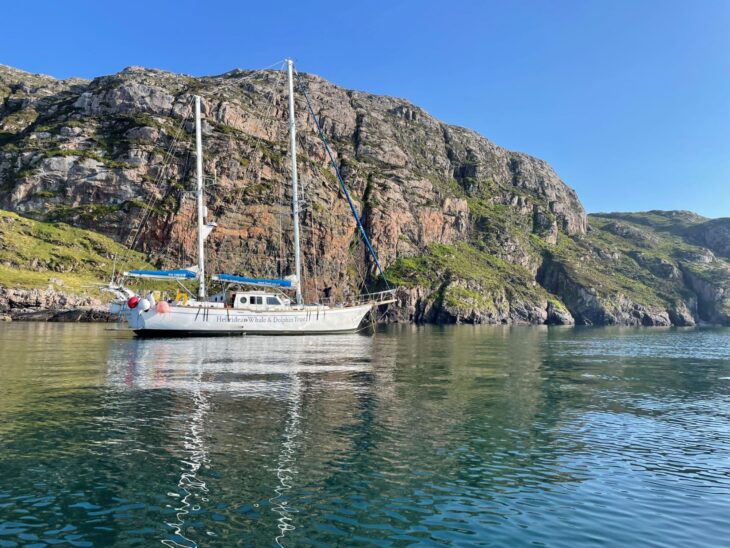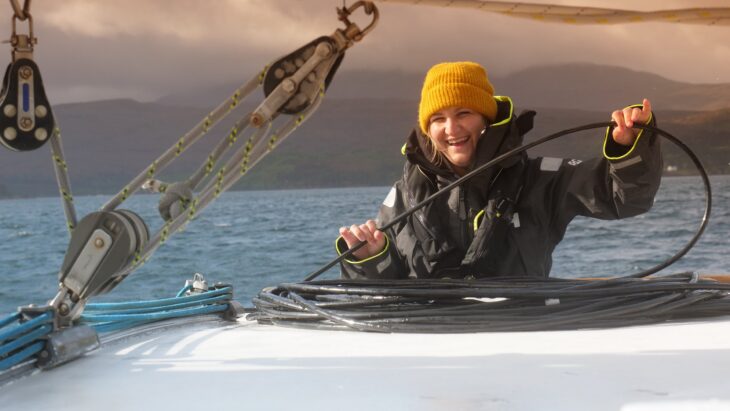Written by Jenny Hampson, Fieldwork Research Manager of the Hebridean Whale and Dolphin Trust (HWDT)
Based on the Isle of Mull, in the heart of the Hebrides, the Hebridean Whale and Dolphin Trust (HWDT) has been leading the way for the conservation of whales, dolphins and porpoises in the waters of western Scotland for over two decades.
We believe evidence is the foundation of effective conservation. Our research has critically advanced the understanding of species that visit seasonally or are resident in the Hebrides. Data are provided to the Scottish Government to inform protection measures for minke whales, Risso’s dolphins, harbour porpoises, and basking sharks across Hebridean seas.
Our flagship research vessel, Silurian, is an icon of long-term monitoring in the field of marine mammal conservation. A recognisable and familiar presence in the Hebrides – she has worked hard – monitoring and protecting areas of critical habitat for whales and dolphins for 20 years.

Each year Silurian and our volunteers travel thousands of nautical miles to monitor whales, dolphins, porpoises and basking sharks off the west coast of Scotland. This pioneering research programme has generated one of the largest coherent databases of its kind for UK waters.
The same rigorous survey methodology has been used for over 20 years, ensuring that the data collected are consistent and comparable between years, providing a wide scale assessment of cetacean distribution and animal behaviour.
Silurian surveys the whole west coast of Scotland, aiming not to repeat the same route twice. By surveying across a wide variety of fine scale environmental variables, (i.e., sea temperature, depth, tidal flow, salinity, etc.) both visually and acoustically, HWDT can answer questions of habitat preference, site usage, and through our photo identification work, animal behaviour.
Human influences and activities, such as underwater noise, fishing, and marine litter, are also monitored to identify emerging threats and understand the conservation implications and risks.
All of these data combined provide a unique and powerful body of knowledge, which is making a real impact for the protection of cetaceans in western Scotland, contributing to the designation of Marine Protected Areas for harbour porpoise, minke whales, basking sharks and Risso’s dolphins, and detecting trends and changes in the marine environment linked to the climate crisis.
Christine Tansey, the Better Biodiversity Data (BBD) project Partnership Officer from the National Biodiversity Network Trust recently joined Silurian on a trip from Ullapool back home to Tobermory. Alongside the HWDT crew and others from NatureScot’s marine survey team, the Marine Mammals Stranding Scheme, photographers and media content creators she got an insight into what sailing with HWDT involves.
Christine explains:
“As someone more used to working with (very stationary!) trees in my previous roles, joining Silurian was an eye-opening experience about the challenges, and solutions, to monitoring mobile species in Scotland’s seas. HWDT is a key organisation supporting marine mammal data collection in Scotland, and demonstrate a model of structured surveys requiring specific training and specialist equipment.
“My weekend on Silurian very clearly highlighted the difficulty of making visual observations of species found beneath the waves, as the sea state can often be too rough to see much from the surface. However, we were able to see how Jenny Hampson, HWDT’s Fieldwork and Research Manager, deployed the towed hydrophone to capture acoustic records of dolphins and porpoises while those of us on deck concentrated on the waves splashing aboard and holding on! We also saw the research station or ‘science nook’ below deck, where the survey teams record visual observations and help process acoustic data, identifying porpoise clicks and other potential species from the recordings.”
HWDT’s Silurian, celebrated a milestone in 2022 – marking 20 years of monitoring Hebridean seas. Over the decades, more than 1,000 people – or citizen scientists – have joined expeditions on board, making Silurian their home for the duration. Trained by our passionate crew and deployed as field biologists, their hard work gathering data underpins this vital long-term monitoring programme. The data gathered by these citizen scientists has generated one of the largest databases of it’s kind in Europe – with acoustic recordings totalling more than a year’s worth of continuous listening, and visual survey effort equating to sailing the world 3 times over. This colossal database has helped better understand the species found in our waters and is used as evidence to demonstrate how important the west coast of Scotland is for whales, dolphins, porpoises and basking sharks.

Anyone can join us on board and we rely on passionate and generous volunteers to continue to this important monitoring work.
Find out more about how you can sail with us, and book a trip in 2024 here: https://hwdt.org/silurian
HWDT will be joining delegates at the NBN Conference in Edinburgh on 23 November, please come and chat to us at our information stand to find out more about our work.
